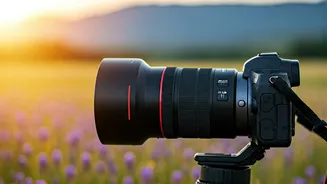Fundamentals of Composition
Composition forms the bedrock of every striking photograph. It's about arranging elements within the frame to create visual harmony and guide the viewer's
eye. The rule of thirds is a foundational guideline, suggesting that placing key elements along the intersecting points of a 3x3 grid can make an image more appealing. Leading lines, such as roads or rivers, draw the viewer's eye towards the subject and add depth. Symmetry and patterns can create a sense of balance and order, while negative space, the empty areas around the subject, helps isolate the subject and provides breathing room. Understanding these elements enables you to make deliberate choices about where to position objects, influencing the message and mood of the photograph. Effective composition ensures that the viewer's attention is drawn to the most important parts of the image and the narrative of the image is easy to understand. Deliberate compositional choices are essential for creating images that are both visually appealing and communicate the photographer's intent.
Harnessing the Power of Light
Light is the lifeblood of photography, defining the mood, texture, and overall look of an image. The direction of light—whether it's front, side, or backlighting—significantly impacts the final result. Front lighting typically illuminates the subject evenly, providing clarity but potentially flattening the image. Side lighting creates shadows and highlights, emphasizing textures and forms, often revealing the subject's three-dimensional nature. Backlighting silhouettes the subject, creating a dramatic effect. Understanding color temperature—the warmth or coolness of light—allows photographers to create specific moods. Warm light, like during sunrise or sunset, adds a feeling of warmth, while cool light, like on an overcast day, can evoke a sense of calmness. Mastering light also involves understanding exposure, controlling the amount of light that reaches the camera sensor. Using aperture, shutter speed, and ISO, photographers can control how much light enters the camera and thereby affect the exposure.
Perspective and Storytelling
Perspective refers to the way objects appear relative to their distance and position from the camera. Choosing the right perspective can drastically change a photograph's impact. A low-angle shot can make a subject appear powerful, while a high-angle shot can provide a broader view of the surroundings. The focal length of the lens also affects perspective; a wide-angle lens captures more of the scene, while a telephoto lens compresses distance, bringing distant subjects closer. Photographs serve as a potent medium for storytelling. They have the power to convey narratives, emotions, and ideas without needing words. Photojournalists use images to document events and tell stories from different points of view, and portrait photographers aim to capture the personality and essence of their subjects. To tell stories effectively, photographers have to think about what story they want to tell and compose images that communicate that story clearly.
The Evolution of Photography
The history of photography is a captivating tale of technological advancement and artistic expression. The birth of photography can be traced back to the early 19th century with pioneers like Nicéphore Niépce and Louis Daguerre. Initially, photography was a complex and time-consuming process. The development of film and cameras simplified the process, making photography more accessible. In the 20th century, the advent of color photography transformed the medium, opening up new avenues for creativity. Digital photography revolutionized the industry in the late 20th and early 21st centuries. Digital cameras offered instant results, allowing photographers to experiment and learn in real time. Mobile phones further democratized photography, bringing the ability to capture images into the hands of billions of people. This constant evolution shows the medium’s adaptability and its continued relevance in the modern world.
Photography's Impact on Life
Photography has profoundly impacted various facets of life, from art and journalism to science and everyday communication. In art, photography has become a primary medium for visual expression, with photographers exploring diverse themes and styles. Photojournalism allows us to witness events worldwide, providing insight and raising awareness about pressing social issues. Science benefits from photography, as it is used for documenting research, creating microscopic images, and making astronomical observations. Beyond its artistic and journalistic uses, photography plays a crucial role in documenting personal experiences, from family portraits to travel snapshots. It allows us to preserve memories, share experiences, and communicate ideas visually. The impact of photography on social media is immense, with images becoming the most common form of communication, influencing culture, fashion, and marketing. Photography helps shape our view of the world and acts as a universal language.








